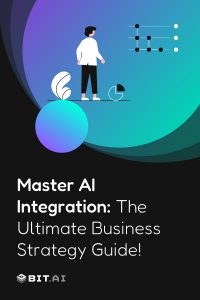Artificial intelligence (AI) is no longer the stuff of sci-fi dreams—it’s the driving force behind business innovation and competition. 55% of business leaders in one study reported that their organizations have already adopted AI to gain a competitive edge. But simply adopting AI isn’t enough; businesses need a well-structured and effective AI strategy that aligns with long-term business goals, enhances operational efficiency, and fuels innovation. In this guide, we’ll explore everything from the evolution of business strategies to AI-powered planning, data strategies, and implementation challenges—all with a sharp focus on making AI work for your business.
What is a Business Strategy?
A business strategy is your company’s game plan—a roadmap that defines your vision, business objectives, and the key steps needed to achieve success. Whether you’re looking to dominate your market, outshine competitors, or optimize operations, your strategy dictates how you allocate resources and position your business. So why exactly does a business strategy matter?
- It helps businesses set clear goals and prioritize initiatives.
- It aligns departments to work towards a common vision.
- It ensures adaptability in changing markets.
Traditionally, businesses have relied on historical data, intuition, and standard industry practices to craft their strategies. But AI is reshaping this landscape—offering predictive insights, automation, and innovation like never before.
How AI is Transforming Traditional Business Strategies
AI isn’t just a fancy tool—it’s changing the way businesses think and operate. Instead of relying on gut instincts or past trends, companies can now use AI to predict what’s coming next, automate decisions, and work more efficiently. It’s like having a superpower for business. AI can analyze huge amounts of data to spot market trends, understand customer behavior, and even anticipate risks before they happen.
AI is also making everyday tasks smoother, from chatbots handling customer service to smarter inventory management and HR processes. Beyond that, AI helps businesses make better decisions by turning raw data into real, useful insights. And when it comes to customers, AI is behind those eerily spot-on recommendations, personalized marketing, and pricing that changes with demand.
The companies that embrace AI aren’t just keeping up—they’re setting the pace for the future. So, the real question is, how will you use it to grow?
How to Build an AI Business Strategy: Step-by-step Guide!
Step 1: Define Your AI Vision
Before diving into AI technology adoption, take a step back and ask yourself: What role will AI play in your business? Are you looking to enhance customer support with chatbots and automated ticketing systems? Do you want to improve marketing campaigns through AI-driven content creation and audience segmentation? Or perhaps optimizing supply chain management with predictive demand forecasting is your main goal? By defining your AI vision early on, you set the foundation for a strategy that aligns with your business objectives rather than just chasing trends.
Step 2: Identify AI Use Cases
Once you have a vision, it’s time to determine where AI can make the biggest impact. Look for areas where automation, data analysis, and AI-driven insights can solve real business challenges. AI-powered chatbots, for example, can provide round-the-clock customer service, reducing wait times and improving user experience. Marketing teams can leverage AI-driven predictive analytics to fine-tune campaigns, ensuring better engagement and higher ROI. AI-powered fraud detection tools can help secure transactions, making financial operations safer. By identifying the most impactful use cases, you can ensure AI becomes a true asset rather than just a shiny new tool.
Step 3: Invest in AI Training and Talent
AI is only as powerful as the people who use it. To truly benefit from AI technology, businesses need to invest in training their teams. Upskilling employees through AI training programs ensures that they understand how to leverage AI-driven tools effectively. Additionally, partnering with artificial intelligence consulting firms or AI-driven platforms can help bridge knowledge gaps and accelerate successful AI implementation. The key is to foster an AI-ready workforce that can adapt and innovate rather than fear automation.
Step 4: Implement AI in Phases
A common mistake businesses make is trying to implement AI everywhere all at once. Instead, start small. Pilot AI tools in one department and assess their impact before scaling company-wide. For instance, test AI chatbots within customer service before rolling them out across other departments. Continuously monitor AI performance, gathering feedback from employees and customers to refine and improve AI integration. This phased approach reduces risk, ensures smoother adoption, and helps businesses fine-tune their AI strategy along the way.
Step 5: Continuously Evolve Your AI Strategy
AI is not a one-and-done solution—it requires continuous refinement and adaptation. As technology evolves, so should your generative AI strategy. Stay updated on AI advancements, regularly evaluate AI-driven processes, and be open to adjusting your approach. Gather insights from real-world AI performance and make necessary tweaks to optimize efficiency and effectiveness. Businesses that embrace AI as an ongoing journey rather than a fixed destination will be the ones that stay ahead of the curve.
By following these steps, businesses can ensure that AI becomes an integral part of their future rather than just a passing experiment. Let’s jump into some hurdles you can face while building a robust AI strategy for business!
Common Roadblocks while Building a Business AI Strategy
Of course, no great strategy comes without its challenges—and AI adoption is no exception. One of the biggest hurdles? Lack of AI expertise. Many businesses find themselves eager to dive into AI, only to realize they don’t have the in-house talent to bring their ideas to life. Developing and deploying AI solutions requires niche skills, and the demand for qualified professionals far outweighs the supply. That’s why investing in employee training and upskilling isn’t just helpful—it’s essential.
Then there’s the question of cost. Implementing AI isn’t exactly cheap. From infrastructure upgrades to advanced tools, the initial investment can be intimidating. But here’s the trick: start small. Pilot projects in specific departments allow you to test, tweak, and scale without overwhelming your resources or your team.
Which brings us to another roadblock—resistance to change. Let’s face it, not everyone is thrilled about AI entering the workplace. Some employees fear it’s here to take their jobs. The truth? AI is a tool for enhancement, not replacement. Through open communication and inclusive training, businesses can help their teams see AI as an ally that automates the mundane and frees up time for more meaningful work.
And finally, we can’t ignore data management. If your data is messy, unstructured, or outdated, your AI systems won’t work as intended. Clean, secure, and well-organized data is the backbone of any effective AI strategy.
The good news? These challenges are solvable. With strategic planning, the right tools, and a shift in mindset, businesses can move past these roadblocks and step confidently into an AI-powered future. And platforms like Bit.ai can simplify this journey—helping you document, organize, and collaborate on your evolving business strategy development with ease.
How Bit.ai Can Help in Building an AI Business Strategy
Implementing an AI business strategy development requires seamless collaboration, documentation, and knowledge management. This is where Bit.ai comes in. Bit.ai, the smartest AI-powered document collaboration platform, simplifies strategy development, enhances workflow efficiency, and ensures businesses can effectively integrate AI into their operations. Let’s explore how Bit.ai can make a difference 🙂


AI-Powered Business Plan Template
Bit.ai provides a customizable Business Plan Template designed to help businesses structure their AI strategies efficiently. With built-in collaboration tools, AI-powered document organization, and real-time editing, teams can create detailed, data-driven plans without the hassle of starting from scratch.
AI-Powered Collaboration and Documentation
With real-time collaboration features, team members can work together on generative AI strategy documents, provide feedback through inline comments, and maintain version control to track progress.
Streamlining AI Strategy Development
Bit’s AI Genius is the best for brainstorming, document collaboration, and strategy execution. Bit’s AI Genius Prompt Library offers 300+ pre-designed prompts to help businesses generate insights, refine strategies, and streamline decision-making. These prompts cover a wide range of AI-related topics, from marketing to implementing frameworks.
Managing Access Permissions for Controlling AI Strategy Sharing
Bit.ai also enables businesses to manage access permissions, ensuring that AI strategy documents are shared with the right stakeholders, investors, or external consultants. Teams can define who can view, edit, or comment on strategy documents, maintaining access controls while facilitating seamless collaboration.
Tracking Engagement and Strategy Execution
With shareable document tracking and engagement analytics, gain real-time insights into how shared documents and wikis are being accessed and interacted with. This helps businesses monitor engagement, optimize their documents, and ensure better decision-making and execution.
Wrapping Up
Companies that embrace AI aren’t just running smoother operations; they’re making smarter decisions, personalizing customer experiences, and outpacing the competition. But here’s the thing—AI isn’t just about fancy algorithms; it’s about how you use it. That’s where Bit.ai comes in. With Bit.ai, teams can document, collaborate, and share knowledge seamlessly, ensuring that AI-driven insights don’t just sit in silos but actually fuel innovation. Whether it’s organizing data, streamlining workflows, or making information easily accessible, Bit.ai helps businesses maximize AI’s potential. The future is AI-powered, but it’s also about how well you manage and share knowledge.
So, are you ready to lead the way with AI and Bit.ai, or will you be playing catch-up 🙂
FAQs
What are the challenges of implementing AI in business strategy development?
Challenges include high implementation costs, skill gaps, data privacy concerns, and resistance to change.
What steps should companies take before implementing AI?
Companies should identify AI use cases, invest in training, and start with small-scale AI implementations before full-scale adoption.
How can Bit.ai help with creating business strategies?
Bit.ai offers AI-powered collaboration tools that streamline brainstorming, documentation, and strategy development, making it easier for businesses to implement AI effectively.
Further Reads:
10 Business Drivers to Grow Your Business!
13 Types of Plans Your Business Must Have!
Business Markets: Definition, 5 Types (with Examples) & Characteristics!
Reasons Why You Should Write a Business Plan!


